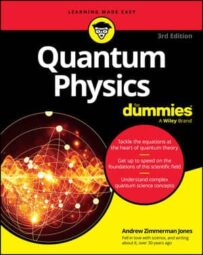How to denote vectors and operators in quantum physics calculations
The mathematical notation used in quantum physics is known as both bra-ket notation and Dirac notation. It is a way of writing quantum vectors in a simplified notation that enables you to act on them without having to get into particulars of the wave function, except for the specific traits that you want to deal with.
Operators
An operator is a mathematical rule that, when operating on a ket, transforms it into a new ket.

Here are several examples of the kinds of operators you’ll see in quantum mechanics calculations:
- Hamiltonian (H). Applying this operator (which looks different for every different physical situation) gives you E, the energy of the particle represented by the ket. E is a scalar quantity:
- Unity or identity (I). The unity or identity operator leaves kets unchanged:
- Gradient (∇). This operator employs derivatives (the varying rate of change of a function with respect to the different position variables) and works like this:

- Linear momentum (P). This operator is used to find the linear momentum; it looks like this in quantum mechanics:
- Laplacian (∇2). You use this operator, which is much like a second-order gradient, to create the energy-finding Hamiltonian operator:

An operator A is said to be linear if it meets the following condition:
Hermitian operators
For an operator A, the Hermitian adjoint is denoted . Here are some useful relationships concerning Hermitian adjoints:
Commutator
The commutator of operators A and B is defined as follows:
Two operators are said to commute if:
How to solve the Schrödinger equation
Quantum physics calculations often come down to solving the Schrödinger equation, which relates the Hamiltonian operator (or energy) to the second-order differential of the wave function. There are a few ways to write the equation, and here’s an example that shows some of the key elements:

Much of the work involved in solving quantum physics equations comes from thinking smarter, not harder, and setting up your equation in a way that makes later steps solvable. You can apply these five general steps toward solving the Schrödinger equation to tackle various problems:
- Determine your coordinates to write the Schrödinger equation.
- Apply specific constraints and simplify, if possible.
- Restructure the Schrödinger equation into a solvable form.
- Solve the differential equation for y.
- Use the boundary conditions and normalization to find the constants.
In some cases, the process hits a roadblock and you repeat earlier steps, possibly redefining the approach with the knowledge of the roadblock that you’re trying to circumvent. This repeating and redefining is part of the intuition that quantum physicists try to develop through years of study in solving the Schrödinger equation in more and more complex situations.
How to work with quantum probability and the wave function
A key physical quantity of interest in quantum physics is the elusive wave function, Ψ(r, t) (based here on radius, r, and time, t). Early in the development of quantum physics, physicist Max Born realized that the wave function was related to the probability that a particle existed in a given location.
Consider a case where the wave function represents a particle. Mathematically, this is represented by the probability density that the particle will be in a small location, written as follows:
You get from the probability density to the probability by integrating the probability across the region of space where you are interested in finding the particle. In other words, finding the probability that the particle would be in some location between r = a and r = b, you’d need to perform the following integration:

This can help you find features of the wave function through the process of normalization, because you know that — if you’re talking about an actual physical particle — it has to exist somewhere in the universe. So, the probability it exists somewhere in the universe is equal to 1, leading you to this integral:

You can then solve this integral as a means of helping to define Ψ(r, t).
A brief history of the wave-particle duality of light
A significant outcome of quantum physics involves resolving two competing theories of light: the particle view and the wave view. Famous scientists such as Newton and Einstein had their own explanations. The transformation in how scientists thought about light, and eventually about matter, is illustrated in this table of the key moments in the developing theories of the wave-particle duality of light.
Key moments in wave-particle duality history
| When It Happened | What Happened |
|---|---|
| Before 1704 | Most natural philosophers, particularly René Descartes and Christiaan Huygens, believed light acted as a wave. |
| 1704 | Isaac Newton published Opticks, in which he explained light as small particles. The math checked out (and it was Newton after all), so most people went along with the explanation. |
| 1801 | Thomas Young performed his double slit experiment, which could really only be explained with light acting as a wave. |
| 1865 | James Clerk Maxwell published the set of four equations that explained light, electricity, and magnetism in the form of electromagnetic waves. |
| 1887 | Albert Michelson and Edward Morley began their series of experiments that failed to detect the light wave medium, the ether. |
| 1905 | Albert Einstein explained the photoelectric effect by treating light as discrete little packets, which later came to be known as photons. |
| 1924 | Louis de Broglie showed that matter also exhibits wave-like properties. He wrote a precise equation describing how a particle’s momentum related to the wavelength of the matter wave. |

